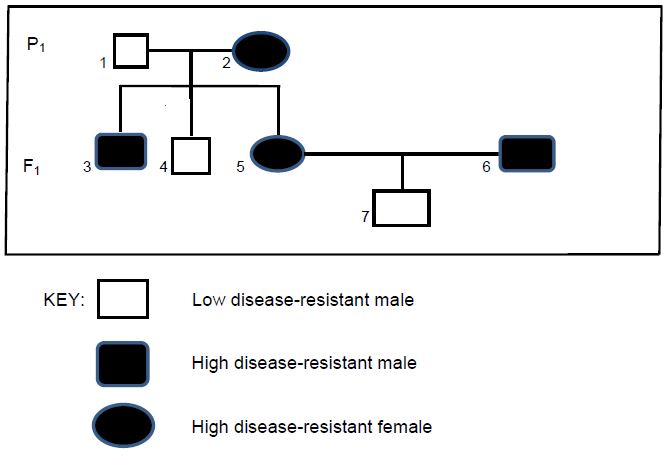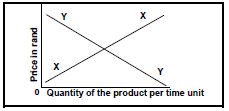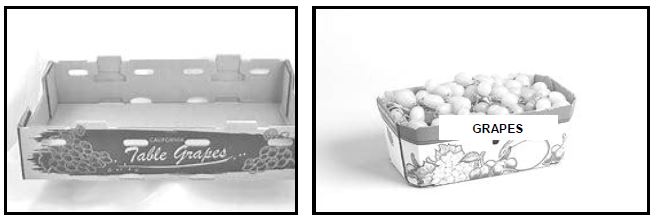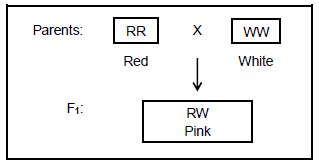AGRICULTURAL SCIENCES PAPER 2 GRADE 12 QUESTIONS - NSC EXAMS PAST PAPERS AND MEMOS MAY/JUNE 2021
Share via Whatsapp Join our WhatsApp Group Join our Telegram GroupAGRICULTURAL SCIENCES PAPER 2
GRADE 12
NATIONAL SENIOR CERTIFICATE EXAMINATIONS
MAY/JUNE 2021
INSTRUCTIONS AND INFORMATION
- This question paper consists of TWO sections, namely SECTION A and SECTION B.
- Answer ALL the questions in the ANSWER BOOK.
- Start EACH question on a NEW page.
- Number the answers correctly according to the numbering system used in this question paper.
- You may use a non-programmable calculator.
- Show ALL calculations, including formulae, where applicable.
- Write neatly and legibly.
SECTION A
QUESTION 1
1.1 Various options are provided as possible answers to the following questions. Choose the correct answer and write only the letter (A–D) next to the question numbers (1.1.1 to 1.1.10) in the ANSWER BOOK, e.g. 1.1.11 B.
1.1.1 A market approach that focuses on a small target segment of the market:
- Price
- Mass
- Multi-segment
- Niche
1.1.2 … in a market divide large shipments of produce to sell them in smaller units.
- Brokers
- Retailers
- Exporters
- Importers
1.1.3 The following is NOT a way to streamline and improve an agribusiness chain:
- Improved access to markets
- Providing storage facilities
- Lack of capital
- Improving road infrastructure
1.1.4 The straight line Y in the graph below represents the … a product.
- market equilibrium of
- shortage of
- demand for
- supply of
1.1.5 A method to improve labour productivity:
- Long working hours
- Lack of education
- Working without supervision
- Better working conditions
1.1.6 The production factor that has a financial value and is a primary natural agricultural resource:
- Labour
- Capital
- Land
- Management
1.1.7 ONE of the following is NOT a problem associated with capital:
- Application of fertilisers
- High risk factor
- Undercapitalisation
- High interest rate
1.1.8 The Labour Relations Act, 1995 (Act 66 of 1995) deals with the following issues:
(i) Procedures for the resolution of labour disputes
(ii) Prevention of unfair labour practices
(iii) Health and safety of workers
(iv) Social justice and fair working conditions
Choose the CORRECT combination:
- (i), (ii) and (iii)
- (i), (ii) and (iv)
- (ii), (iii) and (iv)
- (i), (iii) and (iv)
1.1.9 An example of the phenotype in cattle is the …
- total product of the environmental variation.
- sum of the environmental variation and genetic variation.
- total product of the genetic variation.
- colour of the hair and the presence of horns.
1.1.10 A male animal that has 98 chromosomes will have the following:
- 49 pairs of autosomes and an XY chromosome
- 48 pairs of autosomes and an XY chromosome
- 49 pairs of autosomes and an XX chromosome
- 48 pairs of autosomes and an XX chromosome
(10 x 2)(20)
1.2 Choose a term from COLUMN B that matches the description in COLUMN A. Write only the letter (A–H) next to the question numbers (1.2.1 to 1.2.5) in the ANSWER BOOK, e.g. 1.2.6 J.
| COLUMN A | COLUMN B |
| 1.2.1 The path a product follows from the farmer to the consumer 1.2.2 The costs that depend on production of an enterprise in a farming venture 1.2.3 A form of risk management where a contract ensures guaranteed compensation for losses 1.2.4 The type of farmworker who works throughout the year 1.2.5 An example of biotechnology |
|
(5 x 2)(10)
1.3 Give ONE word/term for each of the following descriptions. Write only the word/term next to the question numbers (1.3.1 to 1.3.5) in the ANSWER BOOK.
1.3.1 The quantity of products demanded exceeds the quantities offered
1.3.2 A legal binding document between the farmer and the farm worker that needs to be signed on employment
1.3.3 A phenotypical expression by which one allele masks the effect of another
1.3.4 A pattern of inheritance in which the expression of one gene is controlled by another gene
1.3.5 The transmission of characteristics from parents to offspring
(5 x 2) (10)
1.4 Change the UNDERLINED WORD(S) in each of the following statements to make them TRUE. Write only the answer next to the question numbers (1.4.1 to 1.4.5) in the ANSWER BOOK.
1.4.1 A marketing approach that responds to increasing concerns about the environment, is advertising.
1.4.2 The provision of incentives and recognition of work with rewards to increase labour productivity is referred to as innovation.
1.4.3 Mass selection is based on the quality of the animal's ancestors.
1.4.4 Colour-blindness is a sex-linked trait which is characterised by blood-clotting failure.
1.4.5 Atavism is the phenomenon in which a characteristic is determined by various pairs of genes.
(5 x 1) (5)
TOTAL SECTION A: 45
SECTION B
QUESTION 2: AGRICULTURAL MANAGEMENT AND MARKETING
Start this question on a NEW page.
2.1 A farmer needs to understand how the market works and how best to place the product.
2.1.1 Define the concept marketing. (2)
2.1.2 Indicate for EACH of the descriptions below, (a) to (c), whether it refers to marketing or selling. Write down only the question number with the answer, e.g. (d) selling.
- Market survey conducted on 300 customers to determine their needs (1)
- Focus on acquiring money to buy a container to sell the produce in that season (1)
- Focus on the number of bags of potatoes sold at a time (1)
2.2 The diagram below shows the demand for maize meal at different prices within a period of two months.
2.2.1 Identify the marketing concept illustrated by demand A and B above. (1)
2.2.2 Give a reason for the answer to QUESTION 2.2.1. (1)
2.2.3 Explain the reason why consumers responded in such a way to the price change. (2)
2.2.4 Identify the factor that led to the difference in the number of bags demanded. (1)
2.3 Avocado pear farmers grouped themselves in order to produce and sell their produce together.
2.3.1 Identify an agricultural marketing system used by the farmers. (1)
2.3.2 Indicate the role of the marketing system in QUESTION 2.3.1. (1)
2.3.3 Name TWO benefits of the marketing system in QUESTION 2.3.1 for the farmers. (2)
2.3.4 State TWO factors that may hamper the marketing of avocado pears. (2)
2.4 The pictures below show the marketing of grapes using specially designed cardboard boxes that have holes on the sides and which are recycled after use.
2.4.1 Identify the marketing function illustrated above. (1)
2.4.2 State THREE characteristics of the cardboard boxes which make them suitable for marketing grapes. (3)
2.4.3 Give ONE reason for using cardboard boxes with holes. (1)
2.5 The following illustrates the table of contents of a business plan:
Business plan Content page |
| Title page ------------------------------------------------------- p. 1 Summary of the enterprise details ----------------------- p. 2 Overview of the enterprise --------------------------------- p. 4 Human resource plan --------------------------------------- p. 8 |
2.5.1 Give ONE aspect that should be included in EACH of the following components of a business plan:
- Title page (1)
- Human resource plan (1)
2.5.2 Name an electronic resource used as a tool for drawing up a business plan. (1)
2.5.3 Give TWO reasons for drawing up a business plan. (2)
2.5.4 State ONE problem that could be encountered when drawing up a business plan. (1)
2.6 Answer the questions below on entrepreneurship.
2.6.1 The statements below indicate the phases of the entrepreneurial process.
Rearrange the phases of the entrepreneurial process below in the CORRECT order by writing down only the letters (A to D).
- Determine the available labour, machinery and equipment.
- Production and supply of goods.
- Plan the business to secure funding.
- Realisation of the absence of suitable products and services.
(4)
2.6.2 SWOT analysis is used in a farming enterprise.
Indicate TWO aspects of the SWOT analysis that are regarded as:
- Internal aspects (2)
- External aspects (2)
[35]
QUESTION 3: PRODUCTION FACTORS
Start this question on a NEW page.
3.1 Match the following economic characteristics of land with the statements below. Write down only the question number and the answer, e.g. 3.1.4 durability.
| specific environment; durability; indestructibility; availability; restrictedness |
3.1.1 The life of soil is unlimited if used correctly. (1)
3.1.2 Only 12% of the soil in South Africa can be cultivated. (1)
3.1.3 Soil may be damaged, but cannot be destroyed. (1)
3.2 State TWO economic functions of land. (2)
3.3
| Government proposed a 5% increase in the minimum wage for farmworkers. Some farmworkers work 10 hours and more per day for six days a week. Researchers have also reported the highest number of new HIV/Aids infections on farms. |
3.3.1 Name the labour legislation used to address the wage issue in the scenario above. (1)
3.3.2 Identify TWO problems experienced by farmworkers in the scenario above. (2)
3.3.3 State TWO ways in which the impact of HIV/Aids infections on farms could be addressed. (2)
3.3.4 Name TWO types of temporary farmworkers based on the terms of employment. (2)
3.4 The table below illustrates a record of income and expenses of a farm with three different enterprises.
| EXPENSES (RAND) | |||||
| DATE | ITEM BOUGHT | CATTLE | TOMATOES | MAIZE | GENERAL |
| 06/01 | Mineral lick | 3 510 | |||
| 08/02 | Medicines | 4 190 | |||
| 10/03 | Fuel | 6 250 | |||
| 11/04 | Truck licence | 720 | |||
| 20/06 | Fertilisers | 14 500 | 2 500 | ||
| 25/07 | Seeds | 2 800 | 800 | ||
| 30/09 | Pesticides | 5 341 | 10 000 | 1 930 | |
| TOTAL | 13 041 | 27 300 | 5 230 | 6 970 | |
| INCOME (RAND) | |||||
| DATE | ITEM SOLD | CATTLE | TOMATOES | MAIZE | GENERAL |
| 10/01 | Maize | 45 000 | |||
| 30/08 | Tomatoes | 160 000 | |||
| 20/12 | Cattle | 455 000 | |||
| TOTAL | 455 000 | 160 000 | 45 000 | ||
| PROFIT/LOSS | - | 132 700 | 39 770 | ||
3.4.1 Calculate the profit or loss of the cattle enterprise from the record of income and expenses above. Show ALL calculations, including the formula. (3)
3.4.2 Compare the tomato and maize enterprises in terms of their profit. (2)
3.4.3 Identify TWO overhead expense items in the income statement above. (2)
3.5
| A farmer inherited a 20 ha farm with machinery, vehicles, livestock and investments in cash, all worth R20 300 000, and credit of R420 000 for a truck. |
3.5.1 Identify the TWO types of capital in the scenario above. (2)
3.5.2 Give the total value of the assets in the scenario above. (1)
3.5.3 Deduce the type of credit obtained by the farmer from the scenario above. (1)
3.5.4 Justify the answer to QUESTION 3.5.3. (1)
3.5.5 Name the capital item that is regarded as a liability in the scenario above. (1)
3.6 The table below shows agricultural products and the prices in 2010 and 2020.
| PRODUCT | 2010 | 2020 |
| Yellow maize (R/ton) | 1 000 | 2 900 |
| Chicken (c/kg) | 820 | 2 400 |
| Wheat (R/ton) | 2 200 | 5 400 |
| Beef (c/kg) | 1 100 | 6 200 |
| Soy beans (R/ton) | 2 500 | 5 700 |
| Lamb (c/kg) | 1 700 | 9 200 |
| Pork (c/kg) | 950 | 2 600 |
| White maize (R/ton) | 1 100 | 3 100 |
Draw a bar graph to compare the prices of animal products in 2010 with those in 2020. (6)
3.7 Differentiate between internal and external forces that influence a farming business. (2)
3.8 Define risk sharing as a strategy of management. (2)
[35]
QUESTION 4: BASIC AGRICULTURAL GENETICS
Start this question on a NEW page.
4.1 A dairy farmer divides the cows into three groups according to the different feeds they are provided with. The cows are genetically identical and are kept under the same conditions. The farmer measures the milk yield. The table below shows the milk yield.
| GROUP | MILK YIELD PER COW PER YEAR (LITRES) | TOTAL NUMBER OF COWS |
| 1 | 0 - 1 999 | 1 |
| 2 000 - 3 999 | 5 | |
| 4 000 - 5 999 | 8 | |
| 2 | 5 000 - 6 999 | 2 |
| 7 000 - 8 999 | 5 | |
| 9 000 - 10 999 | 6 | |
| 3 | 4 789 - 5 999 | 3 |
| 6 000 - 7 999 | 1 |
4.1.1 Identify in the table above the number of cows that produced the highest quantity of milk. (1)
4.1.2 Identify the factor that could have led to the differences in milk yield in the information given above. (1)
4.1.3 Indicate whether the cause of the differences in milk production in QUESTION 4.1.2 is genetic or environmental. (1)
4.1.4 Name TWO genetic causes of variation. (2)
4.2 The diagram below shows a crossing of a white rose plant with a red rose plant, which produced F1-offspring with pink flowers.
4.2.1 Determine the type of dominance in the diagram above. (1)
4.2.2 Use a Punnett square to determine the genotypes of the F2-generation if the F1-offspring interbreed. (4)
4.2.3 Assume that the F2-generation in QUESTION 4.2.2 produced 700 offspring.
Determine the following:
- Phenotypic ratio of the F2-generation (1)
- Number of pink offspring (Show the calculations.)(2)
- Percentage of red offspring (1)
4.3
| A farmer breeds Hereford bulls with traditional Nguni-type cows. The offspring tend to have a higher growth rate and are more resistant to parasites and diseases. |
4.3.1 Identify the animal breeding system applied in the scenario above. (1)
4.3.2 Give a reason for the answer to QUESTION 4.3.1. (1)
4.3.3 Deduce TWO characteristics of the offspring in the scenario above that makes them better than the parents. (2)
4.3.4 State TWO advantages of inbreeding. (2)
4.4 Below is a pedigree diagram that shows the inheritance of disease resistance in a family of goats. R represents high disease resistance and r represents low disease resistance.
- 4 (1)
- 5 (1)
4.4.2 Give a reason for the answer to QUESTION 4.4.1(b). (1)
4.4.3 Indicate the genotypes of the individuals below by referring to the pedigree diagram above:
- 2 (1)
- 7 (1)
4.5 Mutations may make cells look and function differently from normal cells and are sometimes caused by mutagenic agents.
4.5.1 Define the term mutation. (2)
4.5.2 Name TWO types of mutagenic agents. (2)
4.6 The diagram below represents the genetic modification technique in plants.
4.6.1 Identify the genetic modification technique illustrated above. (1)
4.6.2 Label A and D. (2)
4.6.3 Define the structure represented by D. (2)
4.6.4 State ONE advantage of genetic modification over traditional methods. (1)
[35]
TOTAL SECTION B: 105
GRAND TOTAL: 150




